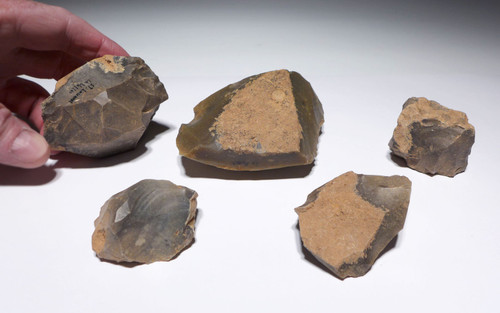Product Description
SEE MORE UPPER PALEOLITHIC TOOLS
This is a collection of FIVE complete flint flake tool cores dating to the Gravettian Culture of the Upper Paleolithic Period of France. The Gravettian culture is known for Venus figurines, which were typically carved from either ivory or limestone. The culture was first identified at the site of La Gravette in the southwestern French department of Dordogne. Cores like this were used by Cro-Magnon humans who once lived where this artifact was found - the famous Department of Dordogne, France, a major locale of Upper Paleolithic occupation in prehistory. A tool core was the "bank of resources" for the stone tool maker. Flakes were struck from the prepared cores and those flakes in turn, were fashioned into tools of various typologies. When the cores were exhausted to yield any more usable flakes, they were discarded or, sometimes made into tools themselves. Each is an excellent example with obvious flake tool removal by human action, and original mineral and sediment deposits in microscopic recesses - a trait only seen in authentic specimens.
No collection of Paleolithic stone tools would be complete without the inclusion of fine examples dating to the Upper Paleolithic Period. This was an era of many of the most famous human development milestones. In this period, the technology developing around the planet took place at slightly different times but globally, humanity was taking a huge turn for the better, and in overall unison. A new level of tool production and craftsmanship emerged unlike ever seen before. Modern humans first arrive on the scene and with them, they bring many new inventions - most notable is the concept of artistic expression as seen in the famous cave paintings that were only produced in this era.
Because the majority of sites that are known to produce Middle and Upper Paleolithic artifacts have been long protected by government regulations and are off-limits to private collecting, the only way to acquire specimens is from old collections that predated these restrictions. As these sites have been off-limits for decades, genuine fine grade Neanderthal and Cro-Magnon human artifacts such as this specimen are most certain to continue to appreciate in value, as time goes on. Paleolithic tools from important sites like this are fast appreciating in value, their sites having been protected and closed to collecting for many decades now.
HISTORY
The Upper Paleolithic was an important dawning of a new age in human history and development. In this period, we find the earliest evidence of organized campsite settlements, some that had storage pits. Human artistic expression blossomed in the form of non-portable art such as cave painting and carved petroglyphs, and portable art such as bone or ivory carvings and engravings. The first evidence of human fishing is also found with the discovery of carved harpoons and hooks. It is likely that warfare amongst people increased as complex social structures emerged with an increasing availability and variety of food, as well as specialized tool types.
The Gravettian was an archaeological industry of the European Upper Paleolithic that succeeded the Aurignacian circa 33,000 years ago. It is archaeologically the last European culture many consider unified, and had mostly disappeared by c. 22,000 BP, close to the Last Glacial Maximum, although some elements lasted until c. 17,000 BP. In Spain and France, it was succeeded by the Solutrean, and developed into or continued as the Epigravettian in Italy, the Balkans, Ukraine and Russia.
The Gravettians were hunter-gatherers who lived in a bitterly cold period of European prehistory, and the Gravettian lifestyle was shaped by the climate. West and Central Europe were extremely cold during this period. Archaeologists usually describe two regional variants: the western Gravettian, known mainly from cave sites in France, Spain and Britain, and the eastern Gravettian in Central Europe and Russia. The eastern Gravettians, which include the Pavlovian culture, were specialized mammoth hunters, whose remains are usually found not in caves but in open air sites.
Gravettian culture thrived on their ability to hunt animals. They utilized a variety of tools and hunting strategies. Compared to theorized hunting techniques of Neanderthals and earlier human groups, Gravettian hunting culture appears much more mobile and complex. They lived in caves or semi-subterranean or rounded dwellings which were typically arranged in small "villages". Gravettians are thought to have been innovative in the development of tools such as blunted-back knives, tanged arrowheads and boomerangs. Other innovations include the use of woven nets and oil lamps made of stone. Blades and bladelets were used to make decorations and bone tools from animal remains.
They developed burial rites, which included the inclusion of simple, purpose-built offerings and/or personal ornaments owned by the deceased, placed within the grave or tomb. Surviving Gravettian art includes numerous cave paintings and small, portable Venus figurines made from clay or ivory, as well as jewelry objects. The fertility deities mostly date from the early period; there are over 100 known surviving examples. They conform to a very specific physical type, with large breasts, broad hips and prominent posteriors. The statuettes tend to lack facial details, and their limbs are often broken off.
 US DOLLAR
US DOLLAR
 EURO
EURO
 AUSTRALIAN DOLLAR
AUSTRALIAN DOLLAR
 CANADIAN DOLLAR
CANADIAN DOLLAR
 POUND STERLING
POUND STERLING














